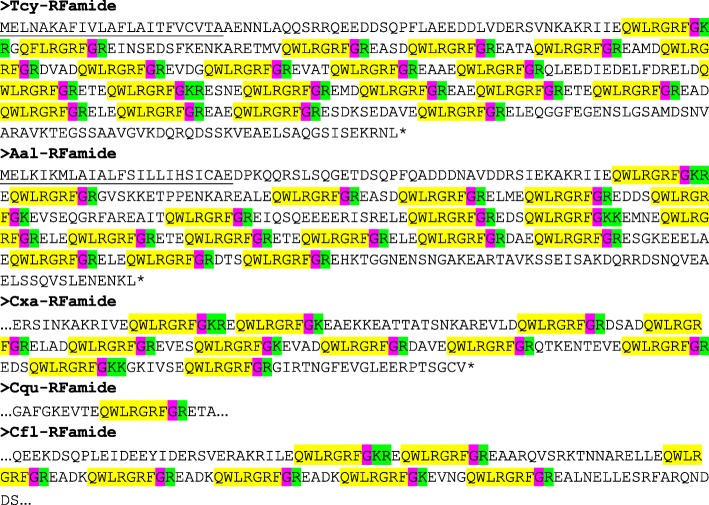Fig. 1.
Amino acid sequences of the RFamide preprohormone from T. cystophora (Tcy-RFamide), A. alata (Aal-RFamide), C. xaymacana (Cxa-RFamide), C. quadrumanus (Cqu-RFamide), and C. fleckeri (Cfl-RFamide). In the complete proteins, the signal peptides are underlined and the stop codons are indicated by asterisks. Prohormone convertase (PC 1/3) cleavage sites (KR, R, KK) are highlighted in green and the C-terminal G residues, which are converted into C-terminal amide groups by peptidyl-glycine α-amidating monooxygenase, are highlighted in red. The above-mentioned processing enzymes liberate peptide fragments (highlighted in yellow) with the C-terminal sequence RFamide. The N-termini of these peptides are determined by Q residues that we assume are converted into protective pyroglutamate residues (pQ) by the enzyme glutaminyl cyclase. These Q residues are often preceded by acidic residues (D or E), which are established processing sites in cnidarians, but not in higher metazoans [21, 29]. These actions would yield 19 copies of Tcy-RFamide-1 (pQWLRGRFamide), and one copy of Tcy-RFamide-2 (pQFLRGRFamide), which are N-terminally protected by pQ residues and C-terminally by amide groups (see also Table 1). In the Aal-RFamide preprohormone (second panel from the top) there are 18 copies of a peptide identical to Tcy-RFamide-1 (see also Table 1). These peptide sequences are preceded nearly exclusively by acidic (D and E) and occasionally by S residues. In the incomplete Cxa-RFamide preprohormone 11 copies of a peptide identical to Tcy-RFamide-1 are present (see also Table 1). Most peptide sequences are preceded by acidic residues, while two peptide sequences are preceded by S residues. From C. quadrumanus (fourth panel from the top) we could only identify a short incomplete preprohormone fragment, containing one copy of a peptide sequence identical to Tcy-RFamide-1. This copy is preceded by an acidic (E) residue. Finally, the incomplete C. fleckeri preprohormone (bottom panel) contains seven copies of a peptide identical to Tcy-RFamide-1. Most copies are preceded by acidic residues, while one copy is preceded by a G and other copies by K residues

